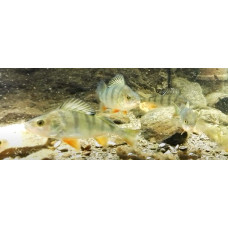Perca fluviatilis is a fish of the perch family. It is up to 40-50 cm long and weighs up to 2 kg. It is widely distributed in fresh water - lakes, rivers, ponds, reservoirs - in Europe (except the Iberian Peninsula, Italy and the northern part of Scandinavia), northern Asia and the eastern part of North America. In large lakes and reservoirs it forms 2 ecological forms. It feeds on insect larvae and zooplankton; the deep perch is a predator. It spawns in early spring at a water temperature of 7-15°C. It lays eggs in the form of a hollow gelatinous tube of about 1 litre or more in length. It is of local commercial importance.
European perch
Tags: european perch



